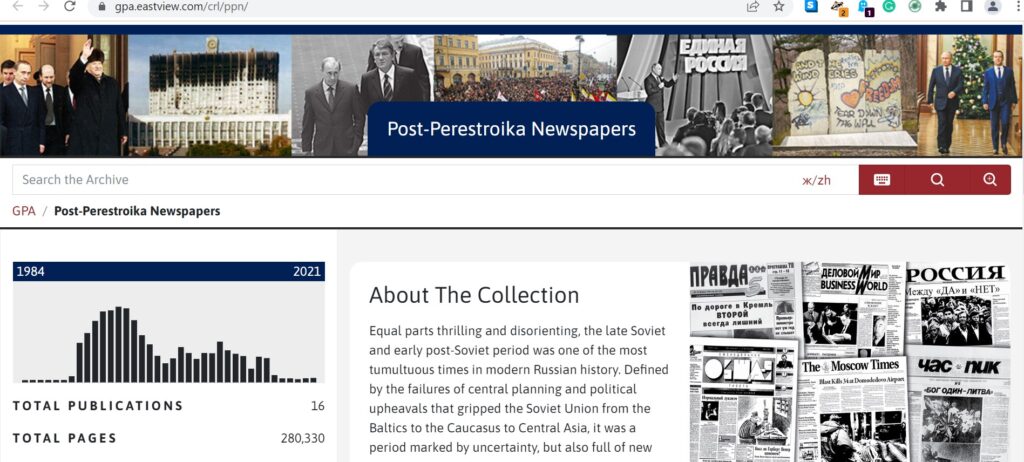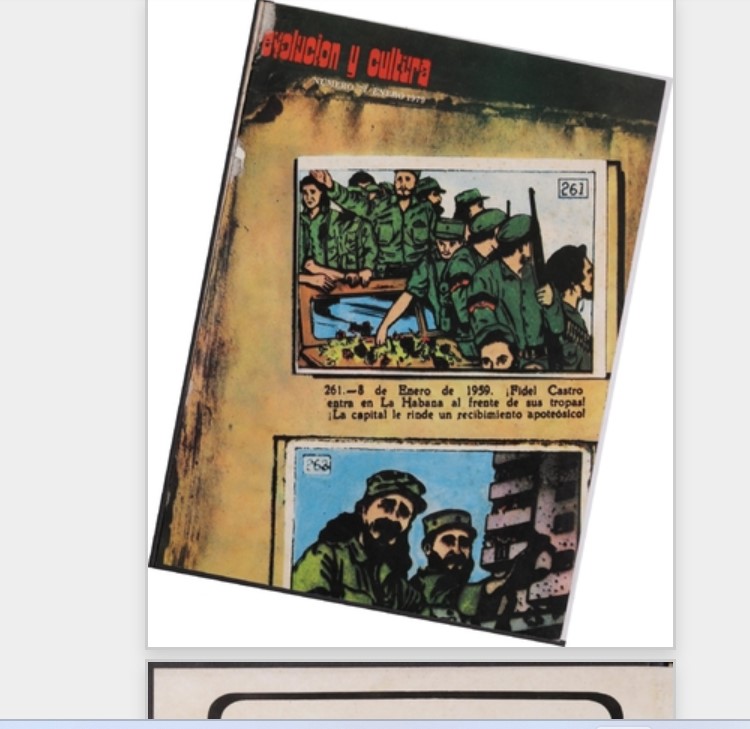Uncategorized
Celebrating the 100th Anniversary of San Francisco Opera
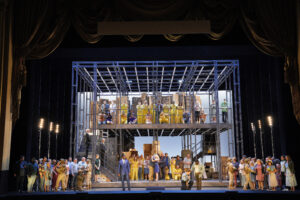
It is with great pride and pleasure that we announce the launch of four new oral histories with San Francisco Opera, continuing a collaboration with the Oral History Center that reaches back decades. In 1973, interviewer Suzanne Riess sat down for interviews with Julian Bagley, who met H.G. Wells and Marian Anderson during his forty years working at the War Memorial Opera House from its opening in 1932! In 1999, Oral History Center interviewer Caroline Crawford conducted an oral history with tenor, voice teacher, and impresario James Schwabacher, whose relationship with San Francisco Opera went back to the 1940s. The San Francisco Opera has benefited from very stable leadership over the past century, with only two general directors during the first sixty years of its existence. This oral history project gained momentum in the 1980s with a three-volume oral history with Kurt Herbert Adler, who was general director of the Opera from 1953 until 1981, and those who knew and worked with him.
In the 2000s, Crawford conducted a number of interviews documenting the conception, creation, planning, management, rehearsal, and performance of an opera commissioned by the Company, John Adams’ Dr. Atomic. For the oral history project Doctor Atomic: The Making of an American Opera, Crawford interviewed composer John Adams, general director of the San Francisco Opera Pamela Rosenberg, music director Sir Donald Runnicles, who conducted the world premiere, music administrator Clifford “Kip” Cranna, and chorus director Ian Robertson. In 2011, Crawford created and oral history with star mezzo-soprano Frederica “Flicka” von Stade, exploring in depth a career in opera performance.
In 2018, we undertook dramaturg emeritus Kip Cranna’s oral history, this time to capture his long career with the opera as a music scholar/ administrator and dramaturg, including his familiarity with the tenures of general directors Kurt Herbert Adler, Terence McEwen, Lotfi Mansouri, Pamela Rosenberg, and David Gockley.
The oral history with general director David Gockley (2006-16) showcased his transformative promotion of “American music theater” that he had pioneered at the Houston Grand Opera. In his time at San Francisco, Gockley focused on dissolving the boundary between opera as high culture and a more democratic and inclusive notion of music theater. He was also an important impresario of new, original compositions by American composers, often in American historical settings.
The oral history with general director Pamela Rosenberg (2001-2006), Gockley’s predecessor, revealed a different approach to opera administration. Although raised and educated in Venezuela and California, Rosenberg spent her entire career in opera administration in Europe, and brought a European sensibility and enthusiasm for adventurous productions to San Francisco. As she began her term in 2001, Rosenberg faced the impact of 9/11 and the dot.com recession. Despite these challenges, she pressed forward with high-risk, high-reward premieres and productions.
The Oral History Center also explored the intersection of San Francisco Opera with the broader community in an interview with Opera Board member Sylvia Lindsey. She was asked to join the Opera Board in 1987, and since then has held a number of positions on committees, in particular to do with education and outreach. She has been a vital force in bringing young people to the opera, but she also fostered inclusion and belonging among the staff and visiting musicians and performers, long before these terms came to stand for common institutional practices. The interview touches on her multiple roles with several arts organizations, highlighting a key facet of her importance as a connector, bringing different people together towards a common purpose.
The pursuit of an art form that is hundreds of years old in the world center of up-to-the-minute technological trends and innovation may seem to be paradoxical, and even a bit quixotic. But the San Francisco Opera is an American story of modernity, resilience, and adaptation. It is about the transplantation of cultural forms from Europe, nurtured early on by many Italian immigrants to the city. It is also about would-be performers growing up in smalltown USA, seeing Beverly Sills on late-night talk shows, and wondering if they too might one day undertake something so grand and beautiful as a calling. But it is also about the ways in which art forms and their institutions can signal and in some ways exemplify elitism, and the efforts of the Opera to move beyond this unintentional cultural positioning through outreach, education, and initiatives of inclusion and diversity. Ultimately, these stories are about broadening the idea of what opera can be, for the performers, for the audiences, and for young people who talk to a singer who visits their schools, attend a performance, see themselves represented on stage, and perhaps dream one day to perform.
This most recent set of interviews is an in-depth exploration of what it means to do art. Creativity is of course the lifeblood of composition, performance, production, and, dare I say, administration. But this project is very much about the drama of the work of performance in all its dimensions. The audience experience of opera performance is certainly visceral. Those soundwaves hit you in your chest. You are, after all, sitting inside the giant horn that is the War Memorial Opera House. The melodies and harmonies open your heart, and the dramatic performance threatens to break it. But what emerges after talking for hours with people who make each of those performances work flawlessly every night is that this art is constructed and expressed on a knife’s edge. The stage manager’s calls sound like an air-traffic controller calmly landing dozens of jets at once. A prima donna falls sick the day of, and a cover, or understudy, steps in to sing a four-hour opera. Many, many things can go wrong at any moment, but the audience experience is only a musical and dramatic catharsis. Radiate out from the excitement behind the scenes of every performance, and you can see the larger drama in which the Opera finds itself: the ups and downs of the market and the tragedies of war and disease that impact the Company, its audience, and the wider community. In short, these interviews are very much about what art means, now and for the ages. For the past one hundred years the San Francisco Opera has been making meaning and beauty for its evolving communities. May it continue to do so long into the future.
Armeno-Indica: Four Centuries of Familiarity and Friendship Conference at UCLA

Armeno-Indica: Four Centuries of Familiarity and Friendship
March 17 – March 18
This event is organized by the UCLA Richard Hovannisian Endowed Chair in Modern Armenian History.
Friday, March 17, 2023, | 10:00 AM – 6:30 PM (Pacific Time)
to
Saturday, March 18, 2023, | 11:30 AM – 6:00 PM (Pacific Time)
Postponed due to the pandemic, this international conference celebrates the bicentenary of the founding of Kolkata’s famed Armenian College (est. 1821), one of three centers of Armenian higher learning in the diaspora during the nineteenth century and the only one that has survived and is thriving today. Bringing together economic, literary, legal, and cultural historians from India, Armenia, France, the United Kingdom, Germany, and the United States, the conference highlights how, beginning in the early modern period and continuing to the present, Armenians have traveled to India to make its distant shores and cultures their own. India looms large in the Armenian social imaginary. It was not only the place where the first Armenian proto-constitution for an “imagined” nation-republic was published (Madras 1788/9), it was also the cradle of the first Armenian newspaper (Madras, 1794-1796), the first modern Armenian play (Calcutta 1823), and arguably also where the first Eastern Armenian novel appeared (Calcutta, 1846), as well as where the first Armenian “feminist” tract (Calcutta, 1847) was published.
Gathering an international group of scholars, Armeno-Indica explores the Indo-Armenian saga in South Asia from the seventeenth to the twenty-first centuries. The themes to be explored include the connected economic, literary, legal, and political histories of Armenians and Indians in South Asia and beyond across the waters of the Indian Ocean. The keynote for the conference will be delivered by Professor Sanjay Subrahmanyam.
Please fill out the form for providing RSVP for in-person attendance. The form is located at the following hyperlink: https://sscucla.qualtrics.com/jfe/form/SV_bgcerNdYzuQgRHU
VENUE: UCLA Royce Hall 314 and Fowler Museum
Alternatively, you may attend this conference using zoom with prior. Here is the hyperlink that will lead you to the form that needs to be filled out: http://bit.ly/armenoindica-virtual
Friday, March 17, 2023 (Royce 314, UCLA)
Welcoming words: Amy Landau and Ann Karagozian
(10:00 AM – 10:15 AM)
Introduction to the conference: Sebouh David Aslanian
(10:15 AM – 10:30 AM)
Panel 1: Trade, Law, and Go-Betweens (10:30 AM – 12:30 PM)
Santanu Sengupta (Kolkata): “Negotiating with Law: Phases of Armenian Interaction with the Early Colonial Law Courts in India.”
Xabier Lamikiz (University of the Basque Country /Euskal Herriko Unibertsitatea (UPV/EHU): “Armenian Merchants from Madras in Eighteenth-Century Spanish Manila: A Story of Love and Hate.”
Ruquia Hussain (Aligarh Muslim University, AMU): “Of Sarhad and Calcutta: The English East India Company, Khwāja Israel di Sarhad and the Foundation of Modern Calcutta.”
Sona Tajiryan (Gemological Institute of America, GIA): “How to Choose and Buy Pearls? An Eighteenth-Century Armenian Guide on the Pearl Trade in India (1730s).”
Discussant: Glenn Penny (UCLA)
Lunch Break: Balcony of Royce 306 (12:30 PM – 1:30 PM)
Panel 2: Language and Literary Revival (1:30 PM-3:00 PM)
Ahona Panda (Claremont McKenna): “Ajab Shahar Calcutta: The Outsider in the Bengal Renaissance.”
Talar Chahinian (University of California, Irvine): “Mobilizing Subjectivity in the Practice of the Nation: Tagheadeants‘s’ Case for Women’s Education.”
Peter Cowe (Near Eastern Languages and Cultures, UCLA): “Intertextuality and Innovation: Mesrop Taghiadeants‘ and his Experimentation with the Novel Genre in Comparative Perspective.”
Discussant: Houri Berberian (University of California, Irvine)
Coffee Break: (3:00 PM – 3:15 PM)
Panel 3: Armenian Historiography and Print Culture in Madras (3:15-5:00PM)
Martin Adamian (UCLA, graduate student): “Mesrovb J. Seth, Father of Indo-Armenian Historiography.”
Anna Sirinian (Dipartimento di Storia Culture Civiltà, Università di Bologna): “Azdarar (1794-1796): The First Armenian Periodical in the World.”
Hasmik Kirakosyan (Senior Researcher, Mashtots Repository of Manuscripts, Yerevan): “Harutiwn Shmavonean an Armenian Printer-publisher in Madras and a Farman for Printing in Arabic script in Madras.”
Discussant: Nile Green (UCLA)
Panel 4: History in the Present (5:00 PM – 6:30 PM)
Armen Arslanian: (Warden of the Armenian Church of Dhaka, Bangladesh): “The Armenian Church of Dhaka (Bangladesh) and the task of Heritage preservation.”
Vache Tadevosyan: (Community leader, Kolkata, India): “The Mardasirakan Jemaran (Armenian College of Kolkata) and its Bicentenary.”
Satenik Chookaszian (Armenian National Gallery in Yerevan): “Sargis Katchadourian’s reproductions of India’s cultural gems from the collection of National Gallery of Armenia.”
Chair and Discussant: Armen Baibourtian
Saturday, March 18, 2023 (Fowler Museum, UCLA)
Check-in at Lenart Hall (11:30 AM – 12:00 PM)
Welcoming remarks: Amy Landau
Panel 1: Monuments, Patronage, and Indo-Persianate Identities (12:00 PM – 2:00 PM)
Sebouh David Aslanian (Department of History, UCLA): “Cemeteries as Heterotopias: Armenian Sepulchral Culture in Agra and Surat, or what the Dead can tell us About the Living.”
Talinn Grigor (Department of Art History, UC Davis): “‘Transimperial’ Strategies of Artistic Patronage: From New Julfan Merchants to Parsi Industrialists.”
Veronika Zablotsky (Freie Universität, Berlin): “Orientalism and the Making of the Armenian Diasporic Imaginary in Early Colonial India.”
Discussant: Peter Cowe (UCLA)
Panel 2: The Historical Imagination and the Circulation of Revolutionary Ideas in Late 18th Century South India (2:00 PM – 3:30PM)
Michael O’Sullivan (The European University Institute, Florence): “Portfolio Capitalism and History-Writing in Hagop Simonean Ayubeant’s Life of Haydar Ali Khan, c. 1782-1795.”
Ayal Amer (UC Irvine): “Fitna and Patriotism in Late 18th century Madras.”
Satenig Badwagan Toufanian (Inalco, Paris): “The Snare of Glory: A Call for Freedom from Madras.”
Discussant: Sebouh D. Aslanian
Intermission: Lemonade, Cookies, and Open Galleries in Courtyard (3:30 PM – 4:40 PM)
Keynote Address (4:40 PM – 5:40 PM)
Sanjay Subrahmanyam (Distinguished Professor & Irving and Jean Stone Endowed Chair in Social Sciences): “Armenians and Others in Mughal Surat: Rethinking Communities, Collaboration and Conflict.”
Reception on the Terrace (6:00m – 7:30 pm)
ORGANIZERS
- UCLA Richard Hovannisian Chair of Modern Armenian History
- Fowler Museum at UCLA
- Armenian Studies Center at the UCLA Promise Armenian Institute
- USC Dornsife Institute of Armenian Studies
- National Association for Armenian Studies and Research (NAASR)
- UCLA Narekatsi Chair in Armenian Studies
- UCLA Center for Near Eastern Studies
Happy International Women’s Day and Conference Dedicated to International Women’s Day!
In many of the world, we enthusiastically celebrate International Women’s Day. We were not aware then of Valentine’s Day and scamming of flower prices then. While the questions surrounding diverse values, gender identities, and contemporary politics are complicated, it is important to note that for many in the world, the basic human rights that we take for granted in the United States are beyond reach. I have been asked today to post a courtesy conference that is not affiliated with our library in which I will participate as a member of the organizing committee in my private capacity. The conference is dedicated to women of contemporary Afghanistan.
The conference will occur tomorrow, March 9th, from 9 am PST through 12 noon. The website for the conference is Afghan Women Speak: Voices from within and beyond. The conference is FREE and OPEN to all with prior registration.
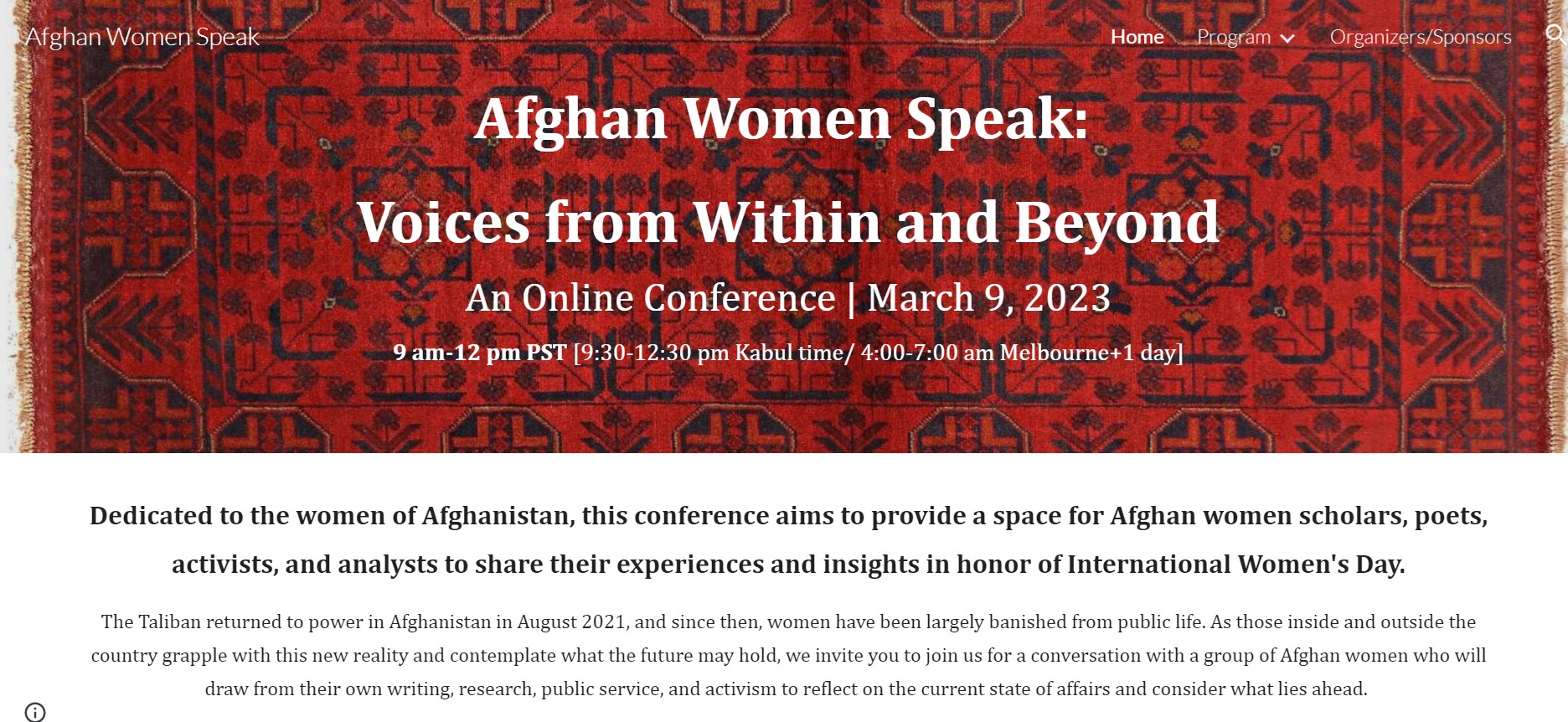
SIGLA: States and Institutions of Governance in Latin America Database
SIGLA (States and Institutions of Governance in Latin America, www.sigladata.org) is a multilingual digital database that freely provides information on legal and political institutions in Latin America. The beta version of SIGLA offers data on national-level institutions in Brazil, Colombia, and Mexico, as well as on international institutions. Ultimately, SIGLA will provide cross-nationally comparable, current and historical, qualitative and quantitative data on over 50 legal and political institutions in 20 Latin American countries in English, Spanish, and Portuguese.
Webinar on February 15: Ukraine Fights On: One Year Later! Episode no. 1
Note: Given the ever-changing situation in Ukraine, this event may be canceled or postponed on short notice.
At this webinar, held nearly one year after the full-scale Russian invasion of Ukraine began, women social activists and a lawyer from the SICH Human Rights Protection Group in Ukraine will provide updates on the current human rights situation and their documentation of the deliberate destruction of the civilian infrastructure in their country. The event includes a screening of the short documentary “Unbroken Women.” This event is the first in a three-part series about the Russia-Ukraine war and its impacts.
The event will be recorded for archival purposes.
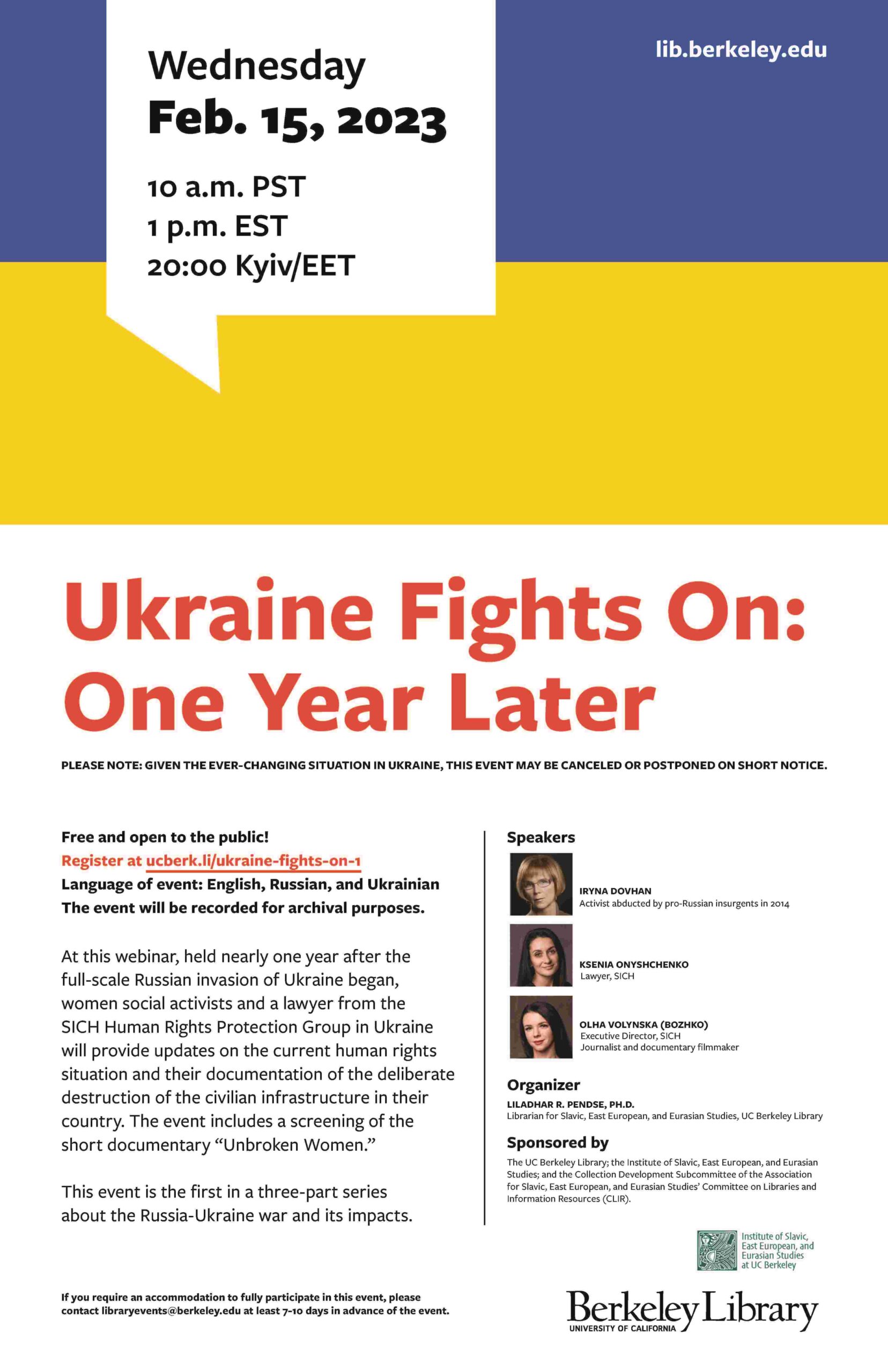
Black History Month Celebration at UC Berkeley Library on Thursday, February 9, 2022 (11 am to noon PST)
Date: February 9th, 2022
Day: Thursday
Time: 11 am to 12 noon PST
Please register here: http://ucberk.li/black-history-month-2023-event
Opening Remarks:
Associate Vice Chancellor of Enrollment Management
Dean of Undergraduate Admissions
Confirmed Speakers:
Professor & 1960 Chair of Undergraduate Education
African American Studies and African Diaspora Studies, UC Berkeley
—
Director, Asian American Studies Program; Co-Director, Council for Race and Ethnic Studies
Professor of Asian American Studies and African American Studies at Northwestern University
Associate Editor, American Quarterly
—
Professor Roopika Risam
Associate Professor of Film and Media Studies and Comparative Literature at Dartmouth College, where she is part of the Digital Humanities and Social Engagement Cluster.
—
Professor Kelly Baker Josephs
Anglophone Caribbean Literature and Digital Humanities, Department of English, University of Miami
Both Professors Risam and Josephs will speak about the Digital Black Atlantic project.
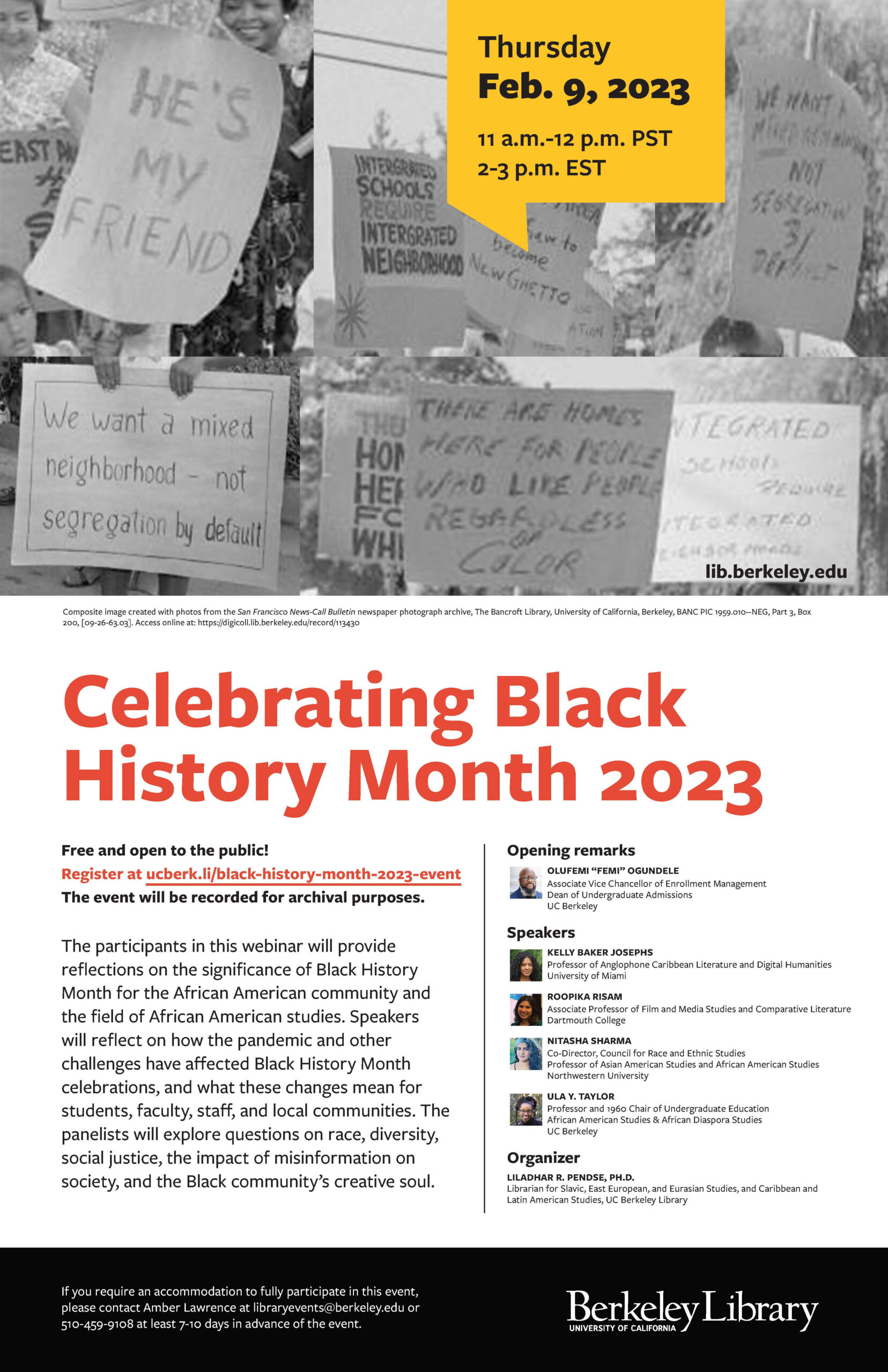
Exhibit: Letters | الحروف How Artists Reimagined Language in the Age of Decolonization
Letters | الحروف How Artists Reimagined Language in the Age of Decolonization

Left to right: art by Mohammed Khadda, Ibrahim El-Salahi, and Bedri Rahmi Eyüboğlu (details)
Letters | الحروف How Artists Reimagined Language in the Age of Decolonization is on exhibit in Doe Library’s Bernice Layne Brown Gallery from March 13 until Aug. 31, 2023. How have modern artists in North Africa, the Middle East, and South Asia made use of their inheritance of a visual cache of Arabic signs and letter-forms, and with what meanings? This exhibition, curated by students in the seminar History of Art 192Cu, “Exhibiting Calligraphic Modernism,” in collaboration with the Library, explores work by dozens of artists in multiple media, from poster design to painting, mosaic, poetry, and animation. A shared backdrop to the artwork on display are the decolonization processes and liberation struggles taking place across Asia, Africa, and Latin America in the 1950s, 1960s, and 1970s, which sparked desires to create cultural futures in resistance to dominant imperial values and official language policies.
Exhibit Curators: Drew Atkins, Riana Azevedo, Lynn Cunningham, Sharan Dulai, Eva Elfishawy, Mohamed Hamed, Teddi Haynes, Murtaza Hiraj, Viv Kammerer, Shanti Knutzen, Marissa Lee, Anneka Lenssen, Val Machado, Jasmine Nadal-Chung, Reyansh Sathishkumar, A. Wara, Alice Xie, Jinyu Xu, Suri Zheng, and Hayley Zupancic
Exhibit dates: March 13 to Aug. 31, 2023
Location: Bernice Layne Brown Gallery, Doe Library
Opening reception
Wednesday, March 15, 2023, 5-6:30 p.m.
Morrison Library
The reception will feature brief remarks by members of the curatorial team. Tours of the exhibition will be led by student-curators beginning at 5:45 p.m. Food and drinks will be served.
A pre-reception event will take place from 2:30-4:30 p.m. in 308A Doe Library, and will include a presentation and Arabic calligraphy workshop by the Bay Area-based calligrapher Zubair Simab. Participants will have an opportunity to try writing Arabic letters with a prepared pen and ink. There are 40 slots available for the workshop. Please register here: http://ucblib.link/calligraphyRSVP.
Both of these events are open to the public.
Details:
Wednesday, March 15, 2023
Pre-reception calligraphy workshop
2:30-4:30 p.m.
308A Doe Library
Register: http://ucblib.link/calligraphyRSVP
Exhibit reception and tours
5-6:30 p.m.
Morrison Library (101 Doe Library)
If you require an accommodation to fully participate in this event, please contact Amber Lawrence at libraryevents@berkeley.edu or 510-459-9108 at least 7-10 days in advance of the program.
Sponsors/contributors: Center for Middle East Studies, Department of History of Art, and UC Berkeley Library
Post-Perestroika Newspapers accessible for the CRL Members
The Post-Perestroika Newspapers collection traces the evolution of post-Soviet Russia, with coverage from 1990 to 2016. Established soon before or soon after the collapse of the Soviet Union, the newspapers in this collection document the changes taking place in Russia, some with breathtaking speed, all the while embracing innovative journalistic methods and standards that were a far cry from the journalism of the Soviet period. These newspapers, some of which had a relatively short lifespan, nevertheless provide essential and critical insight into the events and personalities that defined post-Soviet Russian politics and history (Source:https://gpa.eastview.com/crl/ppn/).
To access these newspapers, please authenticate using the VPN or proxy from an off-campus location.
Trial of Brill’s Revolución y Cultura, 1961–2003 (ending February 21, 2023)
Revolución y Cultura, 1961–2003(Cuba)
Please access the trial through February 21, 2023, here
At UC Berkeley Library, we have several individual issues of Revolución y Cultura, however, Brill has produced a complete digitized archive of it that is searchable. We have set up a trial of this resource through February 21, 2023. We look forward to hearing your comments regarding the utility of this resource in your teaching and research. Please feel free to contact your librarian for the Caribbean and Latin American Studies here.

About:
Revolución y Cultura is a fundamental and often unique resource for the study of more than half a century of Cuban culture. Founded as a biweekly in 1961 under the title Pueblo y Cultura and continued in 1965 as the bilingual magazine Revolution et/and Culture and as RC in 1967, Revolución y Cultura has published uninterruptedly since March 1972. From its foundation until 1977, when the Cuban Ministry of Culture was created, it appeared as the official organ of Cuba’s National Council of Culture.
From 2004 to 2019 it was published both in print and electronically. Since mid-2019, Revolución y Cultura is published online only. Revolución y Cultura is listed in the UNESCO Portal of Culture of Latin America and the Caribbean (Source: Brill)
Tepoztlán Institute 2023: fugitivity, marronage, abolition
TEPOZTLÁN, MORELOS, MÉXICO | July 19 – 26, 2023
Call for participants
DEADLINE TO APPLY: JANUARY 15, 2023Systems of colonization, of exploitation, of citizenship, and of exclusivity produce responses that can be coded as fugitivity and marronage. Those practices of alterity and freedom seek to elude force and violence, but they also invite new forms of placemaking and inclusivity. Abolition – of policing, of carcerality, of national borders, of hierarchical or privileged forms of citizenship – challenges the entrenched forms of the state and opens possibilities for other imaginaries. The Tepoztlán Institute, in its eighteenth year, asks participants to reflect on fugitivity, marronage, and abolition in their many forms in the past, present, and future. How have these practices of freedom been imagined, lived, contested, extended, and reinvented, from the colonial period to the present, across the Americas?
There is a long history of fugitivity and marronage across the Americas. The first maroons in the Americas were Indigenous people fleeing from encomiendas, slavery, and related forms of violence and subjugation in early colonial Hispaniola, and Indigenous practices of flight and assertions of autonomy continued throughout the colonial and national periods. From the quilombos of Brazil and the palenques of Colombia, Panama, Mexico, Peru, and the Spanish-speaking Caribbean, to the maroon societies of Jamaica, Suriname, and the United States, enslaved Africans also engaged strategically in fugitivity and marronage. Though these movements are often siloed, they are not separate: the history of fugitivity and marronage is also one of relationality among Black and Indigenous peoples. Contemporary Black, Indigenous, Latinx, feminist, and queer organizing against state violence and policing and for aesthetic, social, political, and territorial self-determination across the Americas brings these concepts into the present in palpable ways. Fugitivity and marronage have also been central to envisioning past, present, and future liberation.
Like fugitivity and marronage, abolition goes beyond the dismantling of oppressive institutions—it is also the building of autonomy and alternatives that render those oppressive institutions obsolete. In recent years, varied movements and sequences of struggle have forced the politics of abolition into the political mainstream. Many activists, critics, and scholars have framed the abolition of prisons, police, borders, citizenship, and other oppressive institutions as an extension of the struggle that led to the uneven abolition of slavery in the nineteenth century across the Americas. Others have drawn from the long history of fugitivity and marronage to consider the possibilities of escape from and resistance to systems of domination and extraction under racial capitalism, indigenous dispossession, and anti-Black racism. Abolition is one of several important concepts that have been employed within the Americas to imagine different forms of liberation. Taken together, fugitivity, marronage, abolition, and related ideas draw our attention to heterogeneous politics and practices by which another world is built out of and within the ruins of the present.
We invite reflections that address the concepts of, and links between, fugitivity, marronage, and abolition across disciplines, regions, communities, and temporalities. We foresee conversations across scholarly approaches that come from Indigenous studies, Black studies, slavery studies, Latinx studies, and borderlands studies, as well as queer theory and feminisms. Questions may include: Are fugitivity and marronage still applicable to our contemporary moment, or have new concepts supplanted them? What are the limits of bringing the idea of abolition to bear on the present? What is to be left behind or abolished, and what can be saved or repurposed? How have historical and cultural actors navigated the tensions between strategies of fugitivity or escape on the one hand, and inclusion or recognition on the other? How do the concepts of fugitivity, marronage, and abolition help us challenge or reimagine inherited notions of resistance, freedom, liberation, and so on? How can cultural production and representations of Black, Indigenous, and Latinx relationality in studies of fugitivity, marronage, and abolition escape the constrictions of disciplinary knowledge formation? What kinds of cultural production, speculative thought, and activism do fugitivity, marronage, and abolition enable and indeed require? How might movements benefit from more extensive cross-hemispheric dialogue about these issues?
Scholars, activists, and artists may address any historical period, and approaches may draw from a wide range of fields, including but not limited to, history, literature, cultural studies, media studies, art, art history, philosophy, race and ethnic studies, anthropology, and gender and sexuality studies.
IN ADDITION TO THE themes ABOVE, OTHER POTENTIAL THEMES MIGHT include:
● Indigenous, Black, and Latinx coalitions
● Indigenous and Black politics, autonomy, sovereignty, flight, refusal, and recognition.
● Incarceration and decarceration
● Abolitionist feminism
● Migration, detention, and deportation.
● Border abolition
● Asylum and sanctuary
● Fugitivity and patriarchy
● Anarchist theories and practices
● Capture and flight in/from the archives
● Law and legal history
● Queer marronage
● Marronage and sovereignty
● Abolition practices
● Abolitionist geographies
● Speculation/imagination as abolitionist practice
● The politics of policing and police abolition
● Infrastructures for abolitionist practice
● Fugitive thought/science/epistemologies
● Slavery and primitive accumulation
● Marronage and illicit, alternative, and informal economies
● Autonomy and autonomous practices
● Ecological and territorial struggles
The deadline for applications is January 15, 2023. For more information, please consult our website (www.tepoztlaninstitute.org) or write to us at tepoinstitute@gmail.com.

